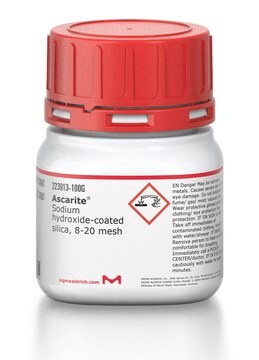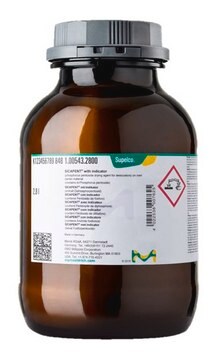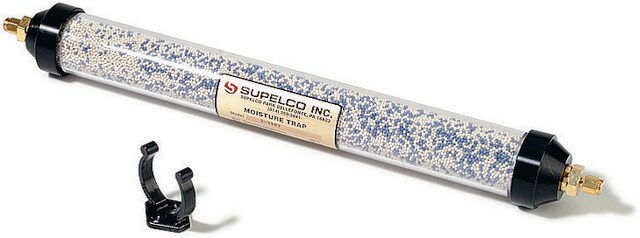223921
Ascarite®
Sodium hydroxide-coated silica, 20-30 mesh
Sinônimo(s):
Ascarite CO2 adsorbent
Faça loginpara ver os preços organizacionais e de contrato
About This Item
Produtos recomendados
Nível de qualidade
Formulário
granular
tamanho de partícula
20-30 mesh
cadeia de caracteres SMILES
[Na+].[O-H]
InChI
1S/Na.H2O/h;1H2/q+1;/p-1
chave InChI
HEMHJVSKTPXQMS-UHFFFAOYSA-M
Procurando produtos similares? Visita Guia de comparação de produtos
Descrição geral
Ascarite® is sodium hydroxide coated silica mainly used as carbon dioxide adsorbents. It is the second generation of the original Ascarite, which was derived from granular asbestos. Ascarite rapidly and quantitatively adsorbs carbon dioxide, (and acid gases), and is useful in a number of analytical and microanalytical procedures, physiological studies, etc.
Aplicação
Ascarite® can be used as a carbon dioxide (CO2) trap.
Características e benefícios
The material is self-indicating, gradually changing color (to white) within a narrow zone due to the formation of sodium carbonate.
Informações legais
Ascarite is a registered trademark of Arthur H. Thomas Co.
Palavra indicadora
Danger
Frases de perigo
Declarações de precaução
Classificações de perigo
Eye Dam. 1 - Met. Corr. 1 - Skin Corr. 1A
Código de classe de armazenamento
8B - Non-combustible corrosive hazardous materials
Classe de risco de água (WGK)
WGK 3
Ponto de fulgor (°F)
Not applicable
Ponto de fulgor (°C)
Not applicable
Equipamento de proteção individual
Eyeshields, Faceshields, Gloves, type P3 (EN 143) respirator cartridges
Escolha uma das versões mais recentes:
Já possui este produto?
Encontre a documentação dos produtos que você adquiriu recentemente na biblioteca de documentos.
Os clientes também visualizaram
Reduction of [11C] CO2 to [11C] CO using solid supported zinc.
Dahl K, et al.
Journal of Labelled Compounds & Radiopharmaceuticals, 60(13), 624-628 (2017)
Highly selective iron-based Fischer?Tropsch catalysts activated by CO2-containing syngas
Chun D H, et al.
J. Catal., 317, 135-143 (2014)
Weiqing Liu et al.
Carbohydrate polymers, 93(1), 199-206 (2013-03-08)
Dissolution of waxy corn starch in 1-ethyl-3-methylimidazolium acetate (EMIMAc) was qualitatively studied and compared with gelatinisation process in water. The rheological properties of starch-EMIMAc solutions were investigated in dilute and semi-dilute regions, from 0.1 to 10 wt% over temperature range
Qiang Yu et al.
Bioresource technology, 129, 592-598 (2013-01-12)
Liquid hot water (LHW), dilute hydrochloric acid (HCl) and dilute sodium hydroxide (NaOH) were applied to sugarcane bagasse (SB). Application of the same analytical methods and material balance approaches facilitated meaningful comparisons of glucose and xylose yields from combined pretreatment
Xin-Cun Yao et al.
Carbohydrate polymers, 94(1), 88-90 (2013-04-03)
Most polysaccharides cannot dissolve in water but can be hydrolysed using hydrogen peroxide (H2O2) to yield a water-soluble product. This study presents a method of preparing water-soluble polysaccharides from peach gum by hydrolysis using H2O2. Extraction was monitored by the
Global Trade Item Number
| SKU | GTIN |
|---|---|
| S220744-1EA | |
| 223921-100G | 4061838778826 |
| 223921-2.5KG | 4061833545348 |
| 223921-500G | 4061835252879 |
Nossa equipe de cientistas tem experiência em todas as áreas de pesquisa, incluindo Life Sciences, ciência de materiais, síntese química, cromatografia, química analítica e muitas outras.
Entre em contato com a assistência técnica







